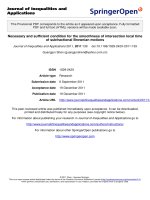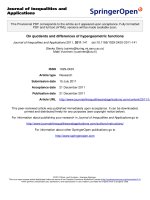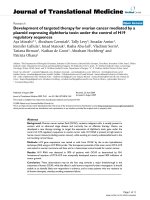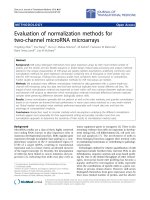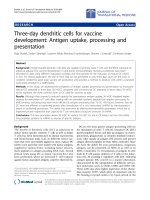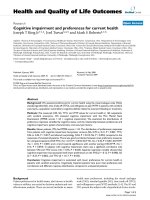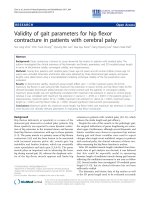báo cáo hóa học: "User-centered virtual environment design for virtual rehabilitation" ppt
Bạn đang xem bản rút gọn của tài liệu. Xem và tải ngay bản đầy đủ của tài liệu tại đây (744.24 KB, 12 trang )
RESEARC H Open Access
User-centered virtual environment design for
virtual rehabilitation
Cali M Fidopiastis
1*
, Albert A Rizzo
2
, Jannick P Rolland
3
Abstract
Background: As physical and cognitive rehabilitation protocols utilizing virtual environments transition from single
applications to comprehensive rehabilitation programs there is a need for a new design cycle methodology.
Current human-computer interaction designs focus on usability without benchmarking technology within a user-in-
the-loop design cycle. The field of virtual rehabilitation is unique in that determining the efficacy of this genre of
computer-aided therapies requires prior knowledge of technology issues that may confound patient outcome
measures. Benchmarking the technology (e.g., displays or data gloves) using healthy controls may provide a means
of characterizing the “normal” performance range of the virtual rehabilitation system. This standard not only allows
therapists to select appropriate technology for use with their patient populations, it also allows them to account
for technology limitations when assessing treatment effica cy.
Methods: An overview of the proposed user-centered design cycle is given. Com parisons of two optical see-
through head-worn displays provide an example of benchmarking techniques. Benchmarks were obtained using a
novel vision test capable of measuring a user’s stereoacuity while wearing different types of head-worn displays.
Results from healthy participants who performed both virtual and real-world versions of the stereoacuity test are
discussed with respect to virtual rehabilitation design.
Results: The user-centered design cycle argues for benchmarking to precede virtual environment construction,
especially for therapeutic applications. Results from real-world testing illustrate the general limitations in
stereoacuity attained when viewing content using a head-worn display. Further, the stereoacuity vision benchmark
test highlights differences in user performance when utilizing a similar style of head-worn display. These results
support the need for including benchmarks as a means of better understanding user outcomes, especially for
patient populations.
Conclusions: The stereoacuity testing confirms that without benchmarking in the design cycle poor use r
performance could be misconstrued as resulting from the participant’s injury state. Thus, a user-centered design
cycle that includes benchmarking for the different sensory modalities is recommended for accurate interpretation
of the efficacy of the virtual environment based rehabilitation programs.
Background
Over the past 10 years, researchers have explored the
use of virtual environments (VEs) as a rehabilitation
tool [1-4]. Although studies have documented successful
re-training and transfer of training while utilizing this
paradigm [5,6], there are few studi es that suggest meth-
ods of designing VEs that transition from specific appli-
cations of cognitive re-training to comprehensive
rehabilitation training programs [7,8]. Given that most
VE applications for cognitive retraining require c usto-
mized applications [9], cost effectiveness is an initial
design consideration [7]. However, there is some evi-
dence that when designed following a user-centered
design cycle, VE plat forms can be valid ly and reliably
applied across therapy scenarios [10].
“Good Fit” assessments are another suggested require-
ment of the virtual rehabilitation (VR) design cycle. The
purpose of these assessments is to ga uge how well th e
VE solution presents real world attributes in a more
controlled, repeatable manner that will allow for com-
parable results over treatment effects [10]. This point
* Correspondence:
1
School of Health Professions, University of Alabama-Birmingham,
Birmingham, AL, USA
Fidopiastis et al. Journal of NeuroEngineering and Rehabilitation 2010, 7:11
/>JNER
JOURNAL OF NEUROENGINEERING
AND REHABILITATION
© 2010 Fidopiastis et al; license e BioMed Central Ltd. This is an Open Access article distributed under the terms of the Creative
Commons Attribution License (http://cr eativecommons.org/licenses/by/2.0), which permits u nrestricted use, di stribution, and
reproduction in any medium, provided the original work is properly cited.
raises an important issue: VE solutions for cognitive
rehabilitation are mostly designed to capture data neces-
sary to evaluate levels of cognitive function or transfer
effects pre and post rehabilitation. As such, they are
inherently guided by experimental design and scientific
principles. This fact argues for standardized design
methodologies when constructing VR environments,
especially for applications that target persons with cog-
nitive impa irments. Lack of standa rdization leads to
redundancy of VE applications and platforms; more
importantly, it makes comparisons across research
endeavors difficult [11].
Intern ational guidelines do exist for designing compu-
ter-based systems that are user-centered and iterative
through out the design lifec ycle. Specifically, the Interna-
tional Standard ISO13407, the Human-Centered Design
Process for Iterative Systems, outlines principles of
human-centered design that account for user context,
computer-syste m design, and environment of use within
an iterative design cycle [12]. Usability evaluation, ease
of use and utility, is a key component to the user-cen-
tered design methodology. The main goals of usability
within the design cycle are to ensure system effective-
ness, efficiency, safety, and utility [13]. VE based trainers
for medical and m ilitary applications involving person
without cognitive impairments have been successfully
designed using the ISO 13407 framework [14,15]. How-
ever, satisfying the recommended guidelines is a subjec-
tive endeavor and determining valid usability testing for
persons with impairments such as anterograde amnesia
may require more medical community agreement.
Further, Stanney [16] contended that human sensory
and motor physiology in general may prove to be limit-
ing factors in some aspects of VE design. The Human-
Computer Interaction (HCI) community has propos ed
varying general VE sy stems design approaches including
those that focus on perceptual issues [17,18], usability
[19,20], or combined perceptual and usability models
[21,22]. Yet, there are several technological and compu-
ter graphics issues that lead to degraded perception in
VEs that may confound VE rehabilitation assessments
[23].
For example, a VE system may utilize a head-worn
display (HWD). M icrodisplays within HWDs typically
limit the user’ s visual resolution acuity [23]. Further,
HWD o ptical systems with a single imaging plane may
also affect the natural accommodation and convergence
mechanisms of the human visual system, thereby
degrading depth cue information [24]. The resulting
visual performance errors have the potential to distort
experimental results, including those obtained from
brain imaging.
When evaluating VE system design, separating the
human component from the engineering component
may prove difficult [25]. Melzer and Moffit [26]
addressed this issue by applying user-centered meth-
odologies to HWD design cycles. Figure 1 represents an
example of a user performance model for HWDs
adapted from Eggleston [27]. The user performance
model outlines the interdependencies of HW D proper-
ties, computer graphics techniques, and their combined
effects upon the user’s perception of the VE. More spe-
cifically, the m odel illustrates h ow errors in the hard-
ware (HWD optics and display) and software (Computer
Graphics) impact the user’s ability to correctly perceive
the construc ted VE space. The user also contributes his
or her individual differences in perceptual abilities (e.g.,
spatial processing) to th e overall error. Thus, the model
must also include a user perception to image level two-
way interaction as illustrated in Figure 1.
Following the user-centered design model, the HWD
designer is not only responsible for u sability from a
user’s perspective, but from the software perspective as
well. Thus, HWD designers are concerned with limits in
HWD parameters such as display resolution (image
quality), field of view (information quantity), and con-
trast (light intensity changes) [28]. Just as with user-cen-
tered HWD design, user-centered VE design considers
the standard limits of the human visual system (e.g.,
visual acuity, contrast modulation, and stereoacuity) as
minimal user requirements for optimal viewing of the
VE scene [29]. In contrast, some researchers suggest
that visual errors may be caused more by the graphical
techniques used to define the spatial layout of the VE
[30,31]. Thus, even with a well designed and calibrated
HWD, the VE may not support proper viewing condi-
tions for successful task completion.
To circumvent these technology, graphics, a nd user
issues, a n interactive and iterative VE design cycle that
includes sensory performance metrics for estab lishing
baselines within a cognitive rehabilitation VE is pro-
posed and diagramed in Figure 2. The design cycle inte-
grates the requirements of the International Standard
ISO13407, while including components of the more suc-
cessful HCI VE design guidelines [22]. Sensory perfor-
mance is measured before and during the design phase
to ensure that the technology assembled is appropriate
for the rehabilitation protocol. In addition, performance
baseline metrics are obtainable. These metrics allow for
the cross comparison of VE rehabilitation systems and
the means to separate user p erformance from technol-
ogy limitations during experimental analysis.
The VE rehabilitation system is not built until the
component technology and graphical methods meet the
task requirements for the rehabilitation protocol. A
more important outcome of this methodology is that
rehabilitation specialists can understand empirically the
best VE system designs for providing effective treatment
Fidopiastis et al. Journal of NeuroEngineering and Rehabilitation 2010, 7:11
/>Page 2 of 12
for persons experiencing cognitive impairments. Thus,
the VE rehabilitation application is extendable to a suc-
cessful, cost effective, and comprehensive rehabilitation
program.
An ongoing impediment to VE system design is that
usability assessments lack appropriate sensory tests
(vision, auditory, smell, and to uch) to pro vide accurate
benchmarks for VE systems (i.e., technologies, computer
graphics, and users). As a step toward narrowing this
gap, we present modules of a vision test battery that
quantifies key components of the human image proces-
sing system, namely resolution visual acuity and depth
perception modules [23,32,33]. In this paper, we shall
present results obtained with the stereoacuity module.
The test battery can be performed when considering dif-
ferent types of VE methods (e.g., augmented reality) as
well as with varying types of display technologies (e.g.,
projectors, monitors or HWDs). The results of such a
battery should provide basic and applied vision para-
meters for the total VE system, which will allow for
appropriate benchmarks and performance evaluations
that control for visual errors (e.g., distorted depth)
within VE based cognitive rehabilitation applications.
Methods
HWD technology
The purpose for performing tasks while wearing a see-
through HWD is that real and virtual world objects are
Figure 1 User-centered VE design approach example. Modified user-centered approach to the head-mounted display design cycle adapted
from R.G. Eggelston (1997).
Fidopiastis et al. Journal of NeuroEngineering and Rehabilitation 2010, 7:11
/>Page 3 of 12
Figure 2 Proposed iterative VE design cycle. Proposed interactive iterative VE design cycle including sensory performance metrics for
establishing baselines within a cognitive rehabilitation VE.
Fidopiastis et al. Journal of NeuroEngineering and Rehabilitation 2010, 7:11
/>Page 4 of 12
combined to make up the task space. For example, some
types of therapy may be best performed utilizing virtual
components (e.g., stove burner s) along with real world
objects (e.g., dials for setting heat) instead of replicating
the total rehabilitation setting in a solely virtual counter
part. There are two choices for see-tho ugh displays and
they are categorized based upon how they merge the
real and virtual scene: optical see-through HWDs
employ a semi-transparent mirror, while video-see
through HWDs use a video camera (see [34] for a com-
prehensive review).
Optical see-through HWDs are typically associated
with augmented reality tasks whereby the virtual world
is overlaid onto real objects [35]. Figure 3 pictures two
optical see-through displays, first and second generation
prototype head-worn projection displays (HWPDs)
whose optics were developed in the ODALab at the Col-
lege of Optics and Photonics at the University of Central
Florida [36]. Because the original stereoacuity assess-
ment was conducted using the bench prototype of the
first generation HWPD (HWPD-1), the HWPD-1 and
HWPD-2 (second generation) were used in the
experiment.
HWPD parameters
Table 1 Technology specifications for HWPD-1 and
HWPD-2 used in experiments. Table 1 provides the
technical specifications for the HWDs worn during the
stereoacuity testing. Information such as display type,
field-of-view (FOV), interpupillary eye distance (IPD)
range, and resolution are important parameters of the
HWD that determine the users’ visual performance. For
example, resolutio n as imposed by the microdispla y can
be estimated by measuring the average subtense of a
single pixel in either the horizontal or vertical dimen-
sion after being magnified by the optics. This resolution
value can be computed from the horizontal or vertical
resolution given in pixels and the FOV for that dimen-
sion. The approximated resolution can then be com-
pared to that of the human visual system. The
resolution visual acuity of the human eye is accepted as
1 arc minute or 20/20 [37]. Comparatively, the mea-
sured resolution visual acuity for users we aring the
HWPD-1 is 4.1 arc minutes (~20/80) and 2.73 arc min-
utes (~20/60) for the HWPD-2 [38]. Thus, the user
wearing the HWPD-2 should be able to see better object
detail than the person wearing the HWPD-1; however,
factors such as display brightness as determined by the
display type (e.g., liquid crystal or organic light-emitting)
and graphical content can play a role in detail visibility.
Most often, researchers do not report the optical
depth plane of the HWD; however, this parameter is cri-
tical to understanding visual perception issues in VEs.
The virtual image created by the HWD is usually mag-
nified and presented at a fixed distance from the obser-
ver, usually between 500 mm and infinity [39,40]. This
fixed distance is based upon the optics of the HWD sys-
tem and may result in conflicts between the accommo-
dation and the convergence mechanisms of the eye.
Although multi-focal plane HWDs have been proposed
[41], they are not available on today’s HWD market. As
a result, the focus distance of HWDs does not
Figure 3 Optical See-through HWD pr ototype s. First (left) and second (right) generation prototype head-mounted projection displays
developed in the University of Central Florida.
Fidopiastis et al. Journal of NeuroEngineering and Rehabilitation 2010, 7:11
/>Page 5 of 12
dynamically change as does the human eye to allow for
focus on near or far objects. Bec ause both optical see-
through displays were custom built, we could adjust the
focus planes for both HWPDs to present the virtual
image at different viewing depths from the observer.
The importance of this adjustment is that the virtual
image and the rendered image are collocated on the
optical plane, thus eliminating the mismatch between
accommodation and convergence mechanisms of the
observers’ eyes.
The optics for HWPD-1 was optimized for infinity
viewin g (i.e., viewing distances > 6 m) by design, thus the
optical depth plane for this display is typically set to dis-
play images at infinity. However, the optics of this display
also allow for adjustments to the optical depth plane, and
thus allow for viewing distances of 800, 1500, or 3000
mm with only a slight decrement in resolution. Compara-
tively, the optics for HWPD-2 were optimized to techni-
cally operate at viewing depths of 800, 1500, and 3000
mm Because of this inherent design specification, the
adjustments of the optical depth plane for HWPD-2 do
not imply a compromise in image resolution. In the
forthcoming experiments, we assessed the participants’
stereoacuity at 800, 1500, and 3000 mm to confirm the
depth presentation capabilities of each display.
It is important to note that the mismatch between the
accommodation and the convergence mechanisms of
the human eye is also accentuated by computer graphics
techniques. More specifically, computer graphics render
objects under infinity viewing conditions because the
virtual cameras are considered as single fixed points or
eyepoints [42]. How computer graphics techniques
interact with technology constraints to impact user per-
formance is another reason that establishing perceptual
baselines are important to include in studies that involve
learning or retraining.
Stereoacuity benchmark test design
Wann and Mon-Williams [17] argued that VEs should
support “salient perceptual criteria” such as binocular
vision that allow for the appropriate p erception of spa-
tial layout, which in turn supports naturalistic interac-
tion (p. 835). Their contention that VEs design must
center upon the perceptual-motor capabilities of the
user is an important design criteria for extending VEs to
rehabilitation scenarios. Rehabilitation scenarios invol-
ving Activities of Daily L iving (ADLs) may necessitate a
level of complexity and realism beyond simple reaching
tasks and manipulating virtual objects to traversing a
virtual grocery store and handling real objects. In addi-
tion, correct spatial locations of objects within a virtual
space may be necessary to support transfer of training
to the home.
Visual performance testing may be difficult since when
viewing a mixed reality scene the visual abilities of the
user are dependent upon the sensory characteristics of
the virtual and real objects (e.g., brightness and contrast)
as well as the layout of the VE space [43]. Further, the
human eye is an optical system that is functionally lim-
ited much like the HWD in such parameters as resolu-
tion. Given that the HWD parameters are designed with
respect to limitations of the human eye, clinical vision
tests which elucidate the functional limitations of the
human e ye are applicable to testing visual performance
when the human eye is coupled with an H WD. Thus,
we chose vision tests associated with established meth-
odologies and real world correlates.
Clinical tests for stereoa cuity can be divided into two
categories, real-depth tests and projected-depth tests.
The Howard-Dolman two-peg test is a classic example
of a real-depth test whereby a real test object is moved
inandoutoftheplaneofoneormoretargetobjects
[44]. The amount of difference in alignment between
Table 1 HWD technology specifications. HWPD-1 and HWPD-2 specifications used in the experiments.
FOV (Degree) Resolution (Pixels)
HMD Type Display Type H V H V Display Size
mm
Focus Plane
mm
IPD mm
HMPD-1 LCD 41 31 640 480 27 × 20 Infinity 55-75
800 40 31 800
1500 41 31 1500
3000 42 32 3000
HMPD-2
800 OLED 33 25 800 600 12 × 9 mm 800 55-72
1500 34 26 1500
3000 34 26 3000
Canon LCD 57 37 640 480 2000 63
VR6 LCD 48 36 640 480 1.3 × 2.59 914 52-74
a Horizontal and Vertical
b Depth of the optical plane (i.e., depth at which the image is rendered)
Fidopiastis et al. Journal of NeuroEngineering and Rehabilitation 2010, 7:11
/>Page 6 of 12
the two objects determines stereoacuity sensitivity.
Stereograms, which present left and right eye perspec-
tive views of an image to the viewer, are examples of
projected-depth tests. Although projected-depth tests
are capable of eliminating most secondary depth cues,
which diminish the accuracy of real-depth tests, the pre-
sentation of these tests are not reliable in VEs [45]. The
modified virtual Howard-Dolman task (V-HD task)
developed by [32] and later improved upon by [33] qua-
lifies in general as a projected-depth test. At this time,
the assessment provides the best metric for measuring
stereoacuity with regard to VE system assessment.
Figure 4 displays each of the stereoacui ty assessments
performed during the experiment. Prior to testing, parti-
cipants were screened using the Titmus Stereo Test, a
standard projected-depth test, to confirm that their
stereoacuity was at least 40 arc s econds. These tests are
showninFigure4aand4b,respectively.Further,the
modified Howard-Dolman peg test using the Howard
Dolman apparatus was per formed before and after VE
testing to monitor changes in visual performance over
the course of the experiment.
The stimuli presented during the V-HD task are pic-
tured in Figure 4c. The V-HD task controls for the
familiar size cues by presenting generic objects, an octa-
hedron and a cylinder), which have no real world corre-
lation [32]. Thus, there is no e xpectation of size when
simultaneously viewing both objects. However, aspects
ofthegraphicssuchaslighting may provide a weak
depth cue. Rolland et al [33] adjusted for conflicts
between accommodation and convergence mechanisms
ofthehumaneyebyplacingthemicrodisplaywith
regard to the optics such that the monocular optical
images matched the location at which the 3D virtual
objects were rendered.
Participants
This research was approved by the Institutional Review
Board (IRB) of the University of Central Florida. Ten
healthy male participants were randomly placed in either
the HWPD-1 (mean age = 29.8, SD = 5.26) or HWPD-2
(mean age = 30.6, SD = 5.36) viewing group. The Titmus
Stereo Test confirmed that participants’ stereoacuity was
at least 40 arc seconds prior to the start of the experi-
ment. As well, each participant was either corrected for
or had 20/20 vision. If needed, glasses or contacts were
worn during each part of the experiment.
Procedure
In this experiment, the partici pant performed the virtual
Howard-Dolman (V-HD) task for two trials at a viewing
distance of 800, 1500 or 3,000 mm. This viewing dis-
tance was randomly selected and each participant
repeated the experiment on separ ate days unti l the
stereoacuity assessment was performed at each distance.
Before and after each virtual trial, the participant per-
formed the modified Howard-Dolman task at the same
viewing distance for th at testing session to monitor pos-
sible changes in the participant’s stereoacuity due to the
VE exposure.
When performing the V-HD task, the HWD was
adjusted for eac h person based upon comfort as well as
IPD for each viewing distance. The virtual cylinder (tar-
get) was rendered at the chosen focus plane (800, 1500,
or 3000 mm) and kept stationary. The virtual octahedron
was randomly placed to the right or to the left of the
cylinder, as well as in front of or behind the target object.
The participant moved the octahedron using a dial so
that its center was aligned with the center of the cylinder.
The response variables for this assessment were: 1)
percent correct for whether the octahedron appeared in
front of or behind the target; 2) t he absolute constant
error defined as the magnitude of the offset between the
aligned objects; and, 3) the variable error or measure of
dispersion about the partici pant’s mean error score. The
equivalence disparity metric (h ), a measure of stereoa-
cuity, was calculated from the absolute constant error
and the variable error metrics [46,38]. The percent
Figure 4 Depth perception tests and examples of stimuli. Titmus stereo test (left), Modified Howard-Dolman Apparatus (middle), Virtual
Howard-Dolman stimuli (right).
Fidopiastis et al. Journal of NeuroEngineering and Rehabilitation 2010, 7:11
/>Page 7 of 12
correct for front and back responses with the stereoa-
cuity values are reported and discussed for each HWD
tested.
Results
Stereoacuity calculated for HWPD-1 and HWPD-2
Figure 5 and 6 show the overall mean stereoacuity
values attained at each viewing distance, for each task,
and each HWPD. The bottom reference line at 20 arc
seconds represents typical stereoacuity values for the
Howard-Dolman task. In Figure 5, the reference line at
240 arc seconds represents the predicted stereoacuity
based on the size of a single pixel as determined by
HWPD-1 parameters, which was previously given as 4.1
arc minutes. The predicted stereoacuity for HWPD-2 is
156 arc seconds or 2.73 arc minutes and appears as the
reference line in Figure 6.
Percent correct front and back for HWPD-1 and HWPD-2
The mean percent correct for responding whether the
octahedron appeared in front of or behind the static
cylinder prior to alignment is shown in Figure 7 and 8
for HWPD-1 and HWPD-2, respectively. This measure
represents a 2 alternative-forced-choice (AFC) response
where any score 75 per cent and above meets the
detection threshold. This threshold is indicated by
dotted lines in both figures.
Discussion
One aim of this study was to introduce a stereoacuity
test capable o f benchmarking HWDs. Stereoacuity of
each HWD was evaluated given their respective display
parameters utilizing a user-in-the-loop methodology.
The results showed that there was no significant differ-
ence between groups when performing the Howard-Dol-
man task at any viewing distance. Thus, subse quent
differences found between the groups may be attributed
to the type of HWPD worn while performing the virtual
Howard-Dolman task.
As figures 5 and 6 show, the participants’ performance
was better than the predicted stereoacuity based on the
pixel size resolution of each display, 240 and 156 arc
seconds, respectively. Participants wearing HWPD-1
performed more variably at the 800 mm viewing dis-
tance; however, as the distance was adjusted toward the
optimized optical plane, participants’ performance
improved significantly, (M
V-HD800
= 186.70 arc sec, SD
= 92.10 arc sec; M
V-HD1500
=133.52arcsec,SD=34.6;
M
V-HD3000
= 41.91 arc sec, SD = 7.18). This result is
expected since the HWPD-1 is designed to perform
Figure 5 HWPD-1 stereoacuity results.HWPD-1-Overallstereoacuity(h) means and 95% Confidence Interval for the Howard-Dolman and
Virtual-HD task at viewing distances of 800, 1500, 3000 mm.
Fidopiastis et al. Journal of NeuroEngineering and Rehabilitation 2010, 7:11
/>Page 8 of 12
Figure 6 HWPD-2 stereoacuity results. HWPD-2 Overall stereoacuity (h) m eans and 95% Confidence Interval for the Howard-Dolman and
Virtual-HD task at viewing distances of 800, 1500, 3000 mm.
Figure 7 HWPD-1 performance measures. HWPD-1-Mean percent correct and 95% CI for front and back judgments on both trials of the V-HD
task over each viewing distance.
Fidopiastis et al. Journal of NeuroEngineering and Rehabilitation 2010, 7:11
/>Page 9 of 12
optimally at infinity viewing conditions. In contrast,
stereoacuity for persons wearing HWPD-2, which is
optically optimized across each viewing distance, does
not change significantly with viewing distance, M
V-HD800
= 81.46, SD = 27.01, M
V-HD1500
= 104.80, SD = 34.70,
M
V-HD3000
= 69.6, SD = 23.05.
These results suggest that HWPD-1 may not be the
best candidate HWD for performing tasks requiring
good stereoacuity in personal space (i.e., within arms
reach). However, HWPD-1 does attain stereoacuity
levels closer to those attained under natural viewing
conditions when the optical depth plane is set to infinity
or the setting for which it was optimized. The stereoa-
cuity levels for HWPD-2 are not maximized for any one
viewing distance. It is known that stereoacuity improves
with improved binocular visual acuity [47,48]. Thus,
although HWPD-2 provides better binocular visual
acuity than HWPD-1, this advantage is diminished for
the 3000 mm condition because of the requirement of
optimizing the optics across the additio nal optical plane
settings. This finding points to the benefit of designing
HWDstotargetaspecificfieldofuseforwhichvisual
task performance must be optimized.
It should also be noted that the stereoacuity scores
obtained when wearing either HWPD are lower than
the predicted real-world stereoacuity values for the same
levels of visual acuity attainable by each HWPD. Real
world stereoacuity predictions for a Snellen score of 20/
80 range from 178 to 200 arc seconds, which matches
the visual acuity attainable by HWPD-1. For a Snellen
score of 20/60, which corresponds to HWPD-2, pre-
dicted stereoacuity values range from 160 to 200 arc
seconds [47,49]. Figures 5 and 6 show that HWPD-1
and HWPD-2 match or best these predicted values.
This improvement in stereoacuity is attributed to antia-
liasing techniques which improve the visibility of edges
of the rendered objects. This result suggests interdepen-
dence between image resolution o f the rendered virtual
objects and computer graphics techniques that should
be accounted for when assessing VE systems for rehabi-
litation therapies.
Figures 7 and 8 display the percent correct responses
for determining whether the octahedron appeared in
front of or behind the cylinder before aligning the
objects while performing the task wearing HWPD-1 or
HWPD-2. While wearing HWPD-1, the participants
were able to perform above threshold for the 800 and
the 1500 mm viewing distances; however, they failed to
meet threshold for the 3000 mm viewing distance. As
Figure 7 shows, participants performed similarly for
Figure 8 HWPD-2 performance measures. HWPD-2- Mean percent correct and 95% CI for front and back judgments on both trials of the V-
HD task over each viewing distance.
Fidopiastis et al. Journal of NeuroEngineering and Rehabilitation 2010, 7:11
/>Page 10 of 12
both repetitions of the task at the 3000 mm viewing dis-
tance, M
V-HD1
= . 62, SD = .17 and M
V-HD2
= . 62, SD =
.11. Thus, the task was difficult for participants to per-
form even with prior exposure to the test stimuli at that
distance.
In comparison, Figure 8 shows t hat participants did
not respond below 9 0% correct when eva luating front
and back initial positions of the octahedron relative to
the fixed cylinder while performing the task wearing
HWPD-2. There are several properties of HWPD-2 that
may contribut e to better performance.First,thedisplay
type is an OLED, Organic Light Emitting Diode, which
provides more brightness and contrast than the standard
LCD, Liquid Crystal Display, of HWPD-1 (Cakmakci,
2006). As well, the increased resolution acuity of the
HWPD-2 also lends to an improved resolvable depth (i.
e., the range of distances in front of and behind the
opt ical plane wher e a single pixel size is just resolvable)
over HWPD-1.
These results suggest that HWD characteristics reduce
stereoacuity for persons with unimpaired vision. This
reduction is quantifiable using the virtual Howard-Dol-
man task. Rehabilitation specialists can compare these
benchmarks to assess the appropriateness of different
HWDs for use in the ir VR protocols. For example,
HWPD-1 may not be an appropriate choice for close
distance therapeutic tasks (e.g., dro pping a letter in a
virtual mailbox) as the stereoacuity limitations may aug-
ment the patient’ s propensity for errors. These design
decisions can occur early in the design process, thus
reducing time and cost while potentially improving the
overall effectiveness of the VR therapy.
Conclusions
HCI guidelines are important in VE systems design;
however, their goals and methods may change to
accommodate for the sensory and perceptual deficits of
persons with cognitive impairment. For example, per-
sons with anterograde amnesia may not remember their
VE exposure even 10 min utes post training. Question-
naires or ver bal report methods may not be appropriate
for this population; however, procedural tasks that sup-
port motor memory may prove useful. Thus, VE design
for VR must match research concerns with the comfort,
the safety, and the acceptability of the user. Research
and safety constraints may be best satisfied with baseline
metrics representing both clinical and unimpaired
populations.
Task characteristics also determine the level of rea-
lism, i mmersion, and overall detail necessary to achieve
the desired training effect. For example, pain manage-
ment and exposure therapies using VE technologies do
not demand high levels of graphical detail or realism to
achieve positive behavioral outcomes [50,51]. However,
rehabilitation protocols for assisting persons wit h spatial
neglect should ensure that distortions of shape and size
constancy, as well as depth errors caused by the VE
technology are controlled or at least understood prior to
therapy and experimentation.
As more technology providers (e.g., haptic devices)
follow, convergence between the engineering and user
requirements will simplify the VE design decision mak-
ing. However, benchmarks addressing user sensory
capabilities across separated and integrated technolo-
gies are necessary when evaluating user performance,
especially when evaluating persons with brain injuries.
These benchmarks are critical to evaluating negative
adaptation effects as well as positive transfer of
training.
More specificall y, we argue that current user-centered
design approaches are too high level to support the
empirical nature of VR. When building a specific rehabi-
litation application, it is appropriate to introduce sen-
sory performance a ssessments after the initial task
analysis is performed. Howe ver, general sensory base-
lines attained via a user-in-the-loop methodology are
the responsibility of the device manufacturer. The goal
of the therapist is not to de termine the individual limits
of the technology from a user perspective, but to define
the integrative effects of t echnology as they a ssist or
detract fro m user performance in a rehabilitation
scenario.
Acknowledgements
This research was supported by the Office of Naval Research Grants
N000140210261 and N00014-02-1-0927, as well as a Link Foundation
Fellowship awarded to the first author.
Author details
1
School of Health Professions, University of Alabama-Birmingham,
Birmingham, AL, USA.
2
Integrated Media Systems Center, University of
Southern California, Los Angeles, California, USA.
3
Institute of Optics,
University of Rochester, Rochester, NY, USA.
Authors’ contributions
AAR provided the foundational concepts for VR system design, including
benchmarking. CMF conceived of the additions to the design cycle,
participated in the design of the stereoacuity test, implemented the study,
performed the analyses, and drafted the manuscript. JPR conceived of the
study along with the stereoacuity test and the experimental design. JPR also
assisted with data analyses and the editing of the manuscript. All authors
read and approved the final manuscript.
Competing interests
The authors declare that they have no competing interests.
Received: 3 August 2008
Accepted: 19 February 2010 Published: 19 February 2010
References
1. Rizzo AA, Buckwalter JG: Virtual reality and cognitive assessment and
rehabilitation: the state of the art. Virtual Reality in Neuro-Physiology
Amsterdam, Netherlands, IOS PressRiva G 1997, 123-146.
2. Rizzo AA, Kim GJ: A SWOT Analysis of the field of virtual rehabilitation
and therapy. Presence 2005, 14(2):119-146.
Fidopiastis et al. Journal of NeuroEngineering and Rehabilitation 2010, 7:11
/>Page 11 of 12
3. Schultheis MT, Rizzo AA: The application of virtual reality technology for
rehabilitation. Rehab Psychol 2001, 46(3):296-311.
4. Rose FD, Brooks BM, Rizzo AA: Virtual reality in brain damage
rehabilitation: Review. CyberPsychol & Behav 2005, 8(3):241-262.
5. Rose FD, Attree EA, Brooks BM, Parslow DM, Penn PR, Ambihapahan N:
Training in Virtual Environments: transfer to real world tasks and
equivalence to real task training. Ergonomics 2000, 43:494-511.
6. Fidopiastis CM, Stapleton CB, Whiteside JD, Hughes CE, Fiore SM,
Martin GM, Rolland JP, Smith EM: Human experience modeler: Context-
driven cognitive retraining to facilitate transfer of learning. CyberPsychol
& Behav 2006, 9(2):183-187.
7. Rizzo AA, Buckwalter JG, Zaag Van der C: Virtual environment applications
in clinical Neuropsychology. Handbook of virtual environments: Design,
implementation, and application Mahwah, NJ: Lawrence ErlbaumStanney K
2002, 1027-1063.
8. Rizzo AA, Kim GJ, Yeh SC, Thiebaux M, Hwang J, Buckwalter G:
Development of a benchmarking scenario for testing 3D user interface
devices and interaction methods. Proceedings of the 11th International
Conference on Human Computer Interaction. Las Vegas, Nevada 2005.
9. Weiss PL, Rand D, Katz N, Kizony R: Video capture virtual reality as a
flexible and effective rehabilitation tool. J of NeuroEng and Rehab 2004,
1-1.
10. Rizzo AA, Bowerly T, Buckwalter JG, Klimchuk D, Mitura R, Parsons TD: A
virtual reality scenario for all seasons: the virtual classroom. CNS
Spectrum 2006, 11(1):35-44.
11. Moreira da Costa RM, Vidal de Carvalho LA: Virtual reality in cognitive
retraining. Proceedings of IWALT 2000, the International Workshop on
Advanced Learning Technology Palmerston North, New Zealand, 4-6
December, Los Alamitos, CA: IEEE Computer Society 2000, 221-224.
12. ISO: ISO 13407- Human-centered design processes for interactive
systems. International Organization for Standardization 1999.
13. Preece J, Rogers Y, Sharp H: Interaction design: Beyond human-computer
interaction. New York, NY: John Wiley & Sons 2002.
14. Stedmon AW, Stone RJ: Re-viewing reality: Human factors of synthetic
training environments. Int Jof Human-Computer Studies 2001, 55:675-698.
15. Riva G: Applications of virtual environments in medicine. Meth of Inform
in Med 2003, 42:524-534.
16. Stanney KM: Realizing the full potential of virtual reality: human factors
issues that could stand in the way. Proceedings of IEEE Virtual Reality
Annual International Symposium ‘95, Research Triangle Park, North Carolina
March 11-15, 1995 28-32.
17. Wann JP, Mon-Williams M: What does virtual reality NEED?: Human
factors issues in the design of three-dimensional computer
environments. Intl J of Human-Computer Studies 1996,
44:829-847.
18. Fencott C: Towards a design methodology for virtual environments.
Poster presented at the User Centered Design and Implementation Workshop
September 30, York England 1999 />kings_manor_workshops/UCDIVE/.
19. Kaur K, Maiden N, Sutcliffe A: Interacting with virtual environments: an
evaluation of a model of interaction. Interacting with Computers 1999,
11:403-426.
20. Bowman DA, Gabbard JL, Hix D: A survey of usability evaluation in virtual
environments: Classification and comparison of methods. Presence 2000,
11(4):404-424.
21. Stanney KM, Mourant RR, Kennedy RS: Human factors issues in virtual
environments: A review of the literature. Presence 1998, 7(4):327-351.
22. Stanney KM, Mollaghasemi M, Leah R, Breau R, Graeber DA: Usability
engineering of virtual environments (Ves): identifying multiple criteria
that drive effective VE system design. Intl J of Human-Computer Studies
2003, 588:447-481.
23. Fidopiastis CM, Furhman C, Meyer C, Rolland JP: Methodology for the
iterative evaluation of prototype head-mounted displays in virtual
environments: visual acuity metrics. Presence 2005, 14(5):550-562.
24. Wann JP, Rushton S, Mon-Williams M: Natural problems for stereoscopic
depth perception in virtual environments. Vision Research 1995,
35(19):2731-2736.
25. Kalawsky RS: The science of virtual reality and virtual environments: a
technical, scientific and engineering reference on virtual environments.
Wokingham, England: Addison-Wesley 1993.
26. Melzer E, Moffit K: Head Mounted Displays: Designing for the User New York,
NY: McGraw-Hill 1997.
27. Eggelston RG: User-centered design in the trenches: Head-mounted
display system design and user performance. Head Mounted Displays:
Designing for the user New York, NY: McGraw-HillMelzer JE, Moffit K 1997,
17-54.
28. Task HL: HMD Image source, optics, and the visual interface. Head
Mounted Displays: Designing for the user New York, NY: McGraw-HillMelzer
JE, Moffit K 1997, 55-82.
29. May JG, Badcock DR: Vision and Virtual Reality. Handbook of Virtual
Environments Technology Lawrence Erlbaum Associates, IncStanney KM
2002, 29-63.
30. Cutting JE, Vishton PM: Perceiving layout and knowing distances: The
interaction, relative potency, and contextual use of different information
about depth. Perception of space and motion San Diego, CA: Academic
PressEpstein W, Rogers S 1995, 69-117.
31. Ellis SR: Seeing. Pictorial communication in virtual and real environment
Washington, DC: Taylor & FrancisEllis SR, Kaiser MK, Grunwald AJ 1993,
419-424.
32. Rolland JP, Gibson W, Ariely D: Toward quantifying depth and size
perception in virtual environments. Presence 1995, 4:24-49.
33. Rolland JP, Meyer C, Arthur K, Rinalducci E: Methods of adjustments
versus method of constant stimuli in the quantification of accuracy and
precision of rendered depth in head-mounted displays. Presence 2002,
11(6):610-625.
34. Rolland J, Fuchs H:
Optical versus video see-through head-mounted
displays in medical visualization. Presence 2001, 9(3):287-309.
35. Davis L, Rolland JP, Hamza-Lup F, Ha Y: Enabling a continuum of virtual
environment experiences. IEEE Computer Graphics and Applications 2003,
2-4.
36. Rolland JP, Hua H: Head-mounted display systems. Encyclopedia of Optical
Engineering New York, NY: Marcel DekkerDriggers RG 2005, 1-13.
37. Goss DA, West RW: Introduction to the optics of the eye Boston, MA:
Butterworth-Heinemann 2001.
38. Fidopiastis CM: User-centered virtual environment assessment and
design for cognitive rehabilitation applications. PhD dissertation,
University of Central Florida, Orlando, FL. Dissertations & Theses database
2006, (Publication No. AAT 3233649).
39. Cakmakci O, Rolland J: Head-worn displays: a review. IEEE/OSA Journal of
Display Technology 2006, 2(3):199-216.
40. Velger M: Helmet-mounted Displays and Sights Boston, MA: Artech House,
Inc 1998.
41. Rolland JP, Kreuger MW, Goon A: Multifocal planes head-mounted
displays. Applied Optics 2000, 39(19):3209-3215.
42. Robinett W, Rolland JP: A computational model for the stereoscopic
optics of a head-mounted display. Presence 1992, 1(1):45-62.
43. Bullimore MA, Howarth PA, Fulton J: Assessment of visual performance.
Evaluation of human work: a practical ergonomics methodology Nottingham,
U.K.: Taylor & FrancisWilson JR, Corlett EN 1995, 804-839.
44. Reading RW: Binocular Vision: Foundations and Applications Boston, MA:
Butterworth Publishers 1983.
45. Wong BP, Woods RL, Peli E: Stereoacuity at distance and near. Opt and Vis
Sci 2002, 79(12):771-778.
46. Ogle KN: Visual optics and the optical space sense. The Eye New York, NY:
Academic PressDavidson H 1962, 4:271-324.
47. Donzis PB, Rapazzo JA, Burde RM, Gordon M: Effect of binocular variations
of Snellen’s visual acuity on Titmus stereoacuity. Arch Opthalmol 1983,
101:930-932.
48. Goodwin RT, Romano PE: Stereoacuity degradation by experimental and
real monocular and binocular amblyopia. Invest Ophthal Visual Science
1985, 26:917-923.
49. Menon V, Bansal A, Prakash P: Randot stereoacuity at various binocular
combinations of Snellen acuity. Indian J of Opthal 1997, 45(3):169-171.
50. Rothbaum BO, Hodges LF: The use of virtual reality exposure in the
treatment of anxiety disorders. Behav Mod
1999, 23(4):507-525.
51. Hoffman HG, Patterson DR, Carrougher GJ, Sharar S: The effectiveness of
virtual reality based pain control with multiple treatments. Clin J of Pain
2001, 17(3):229-235.
doi:10.1186/1743-0003-7-11
Cite this article as: Fidopiastis et al.: User-centered virtual environment
design for virtual rehabilitation. Journal of NeuroEngineering and
Rehabilitation 2010 7:11.
Fidopiastis et al. Journal of NeuroEngineering and Rehabilitation 2010, 7:11
/>Page 12 of 12
